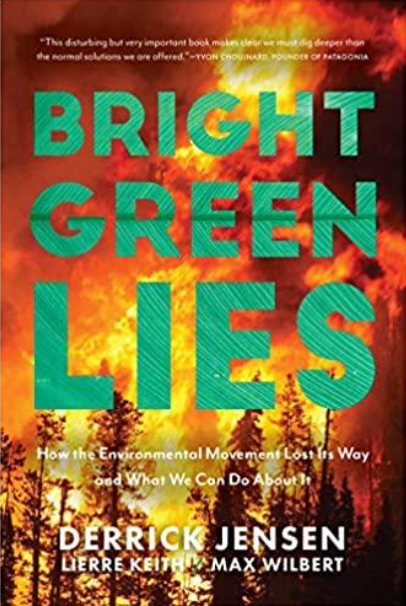How the Environmental Movement
Lost Its Way & What We Can Do about It
By Derrick Jensen, Lierre Keith, & Max Wilbert, 1202
“Overwhelming Obstacles, No Practical Solutions”
Derrick Jensen and his coauthors are so fanatical that it’s hard to take them seriously. He notes that “there were perhaps 5 million human beings living on earth on the day this started” – the beginning of agriculture 12,000 years ago, “when the war against the earth began” (pg. 3). “Fossil fuel is an accelerant, but it’s not the reason. The catastrophe is civilization itself.” (pg. 251). All this suggests that Jensen’s utopian dream for planet earth is the elimination of 99.9% of current humanity and all vestiges of “civilization” from every corner of the planet – back to a stone age of hunter-gathers.
Any environmentalist who does not embrace this sentiment is labeled a “bright green” liar. But to avoid the obvious genocidal / suicidal implications, the authors never provide any insight, let alone a blueprint, as to how all this is supposed to come about. Instead in their final chapter on “Real Solutions” they back off from their initial logic, declaring that “industrial civilization is incompatible with life on the planet”.
Now we can breathe a little easier – it’s perhaps the year 1750 and the elimination of only 90% of humanity, with animal-powered agriculture having somehow become sustainable. Then this “doesn’t mean killing all humans. . . [only] changing our lifestyle dramatically” (pg. 433). This leads to a long list of actions that must happen, many seemingly reasonable, but with nary a hint as to how to work the politics. All the authors can muster is “we need organized political resistance” (pg. 459).
The more useful parts of this book examine the limitations and downsides to the renewable technologies and other fixes offered by mainstream environmentalists and corporate enthusiasts. Here the authors score some valid points, but the tradeoffs involved in real-world politics are replaced by a divisive blame game. This means that specific well-known environmentalists and their organizations are targeted for insufficient purity to the cause, while the actual fossil-fuel powered industries are left unscathed. So, yes, the environmental movement certainly needs to be kept honest, but this book attempts to destroy its legitimacy altogether – a gift to the status quo.

It’s a thick book with multiple chapters devoted to debunking so-called renewables – solar, wind, hydro, and biofuel power, plus extensive statistics on the poor record of recycling and the unsustainability of cities. But the latter is something of a straw man in that the issue is the sustainability of civilizations, not cities. Their critique of economic “efficiency” is more to the point in that increasing technological and commercial efficiency has led to the “Jevons paradox” of industrial civilization. That is, lowering the costs of production mostly leads to more production and social complexity, not leisure time for the working classes or more earth friendly practices.
Yet the authors fail to note that as nature imposes real limits to growth, societies will be hard put to even maintain their current systems and infrastructure. Thus technological and social developments that simplify life will finally come to the fore – out of sheer necessity. The more strongly these simplifications are resisted the more they will feel like collapse rather than creative adaptations.
However, the authors correctly highlight some sobering numbers. Example: “Even with huge subsidies to renewables, wind and solar combine for a whopping 3.3% of all German energy consumption” (pg. 41). Globally, dams account “for 23% of all methane emitted because of humans” (pg. 45) – due to decaying vegetation at the bottoms of reservoirs, released when this water is churned up by turbine generators. “Almost half of Germany’s timber production is simply cutting down trees, pulping them, drying them into pellets, and burning them” (pg. 48) as biofuel, with major biofuel production for Europe globally, even from southern US forests.
Another major limitation of renewables is that they target electricity, whereas “in Germany, electricity accounts for only about 20% of the energy consumed” (pg. 58). In addition, “one paper published in 2015 calculate that the solar systems in northern Europe have a negative energy return on energy invested” (pg. 72). From the authors’ point of view, solar energy is “just another way to power industrial capitalism” (pg. 91).
Another chapter digs into the production of solar panels, including all the costs and pollution associated with the production and distribution of silicon and rare earth metals, noting that “one container ship can emit as much pollution as 50 million” cars (pg. 105). Similarly, windmills depend on steel, and “the production of steel and metallurgical coke is the third largest source of greenhouse gas emissions, after fossil fuels and electricity generation” (pg. 123). Meanwhile recent research “has shown that for every unit of green power brought online only 1/10th as much fossil fuel is taken offline (pg. 154).
Energy storage is another Achilles heel of solar and wind, since both are intermittent. The authors note that “500,000 gallons of water are needed to produce one ton of lithium”, while “[j]et fuel is 43 times more energy dense than the best batteries available today. The brutal truth is that oil is functionally irreplaceable for an industrial economy” (p 158). While certainly true today, we can’t predict the future, illustrating another weakness of this book. That is, with history as our guide, we can expect some surprising developments, for good and bad.
The authors do give some credibility to the European “degrowth socialists” but dismiss them as a “fringe idea” (pg. 246). Instead of exploring the strengths and weaknesses of this growing movement and of U.S. counterparts like the Post Carbon Institute, they bring out their heavy artillery to demolish the pie-in-the-sky numbers of Mark Jacobson, the leading academic apostle for a renewable energy economy.
Instead of the destructive defeatism of this book, I’d suggest something more creative and hopeful, a viable transition strategy, such as a degrowth version of a Green New Deal – at least a step in the right direction toward more economic diversity and resilience.
Find the book here.
